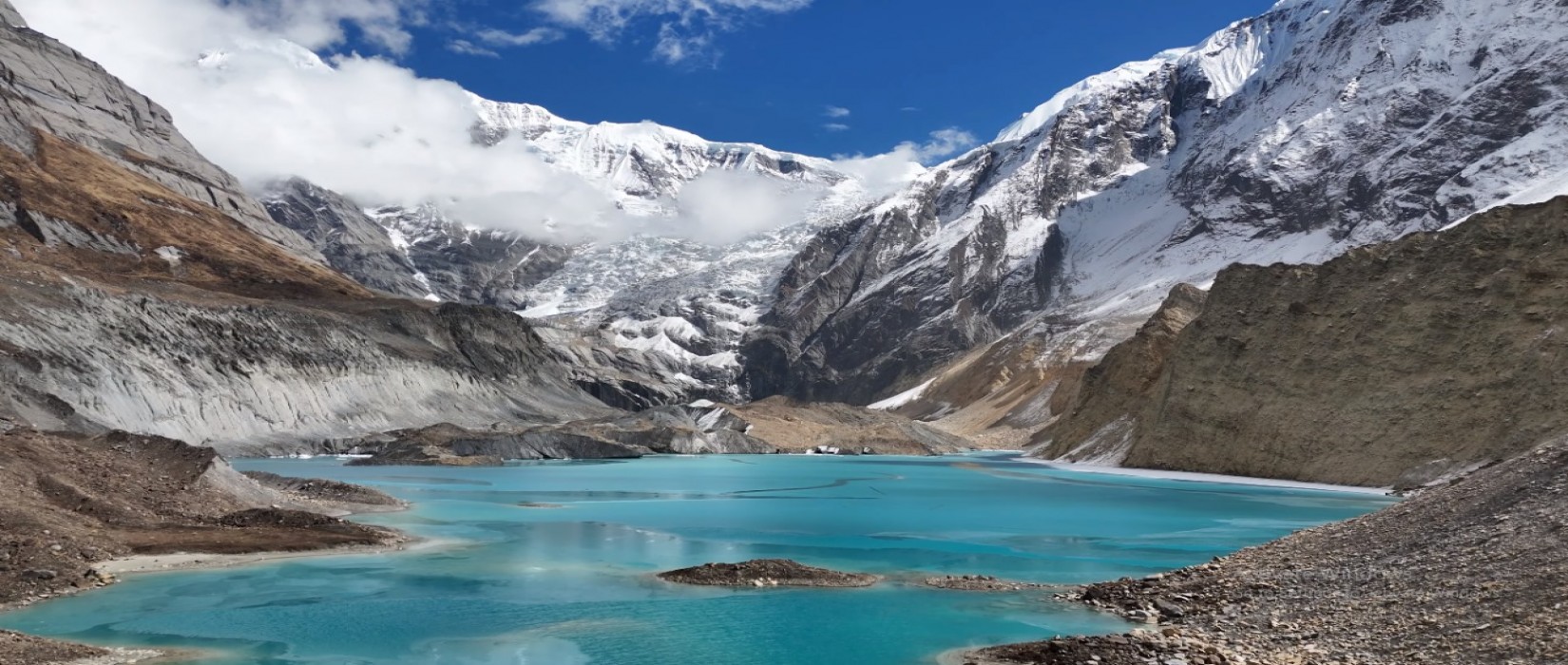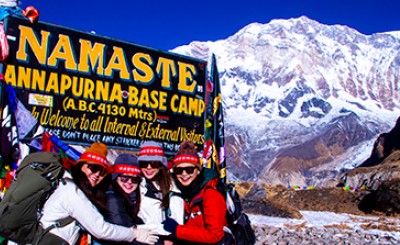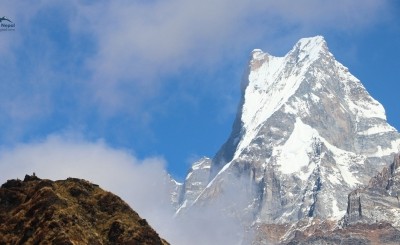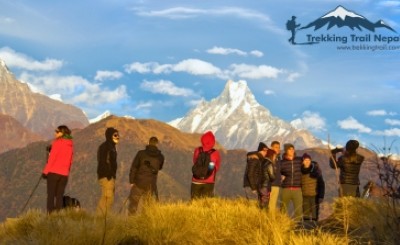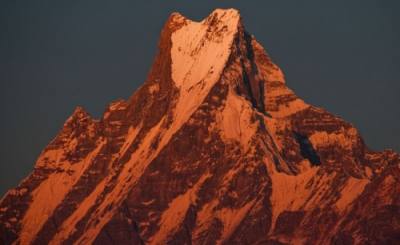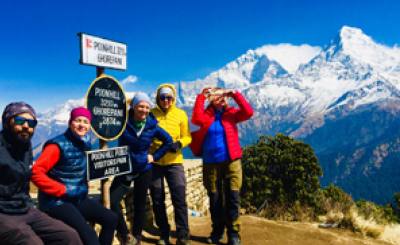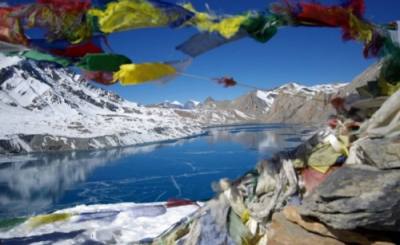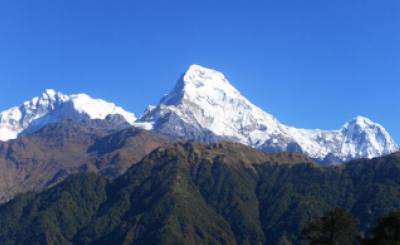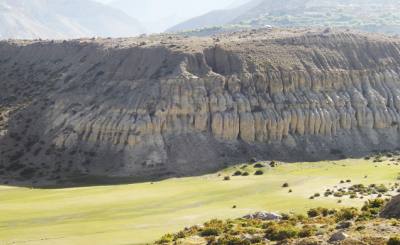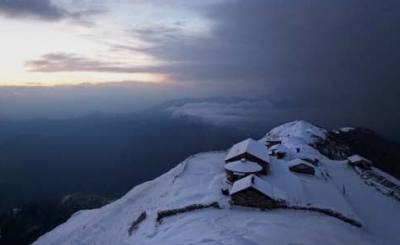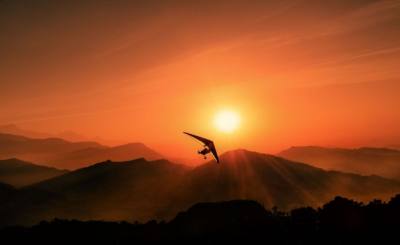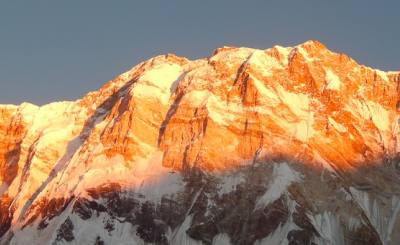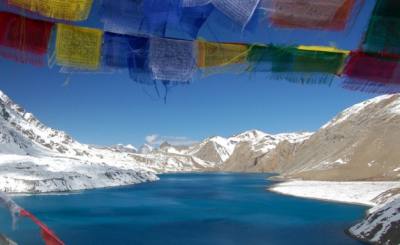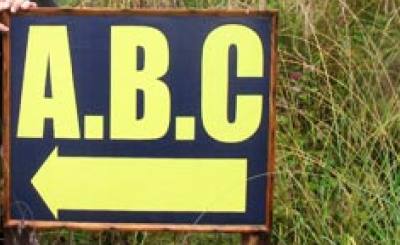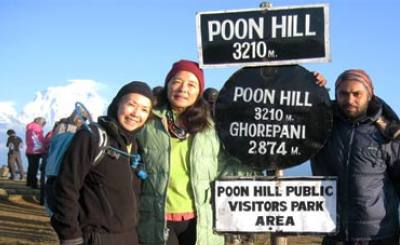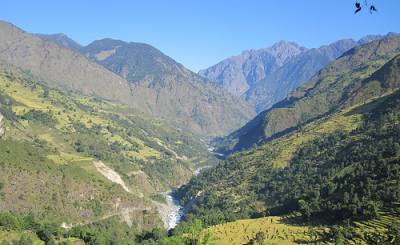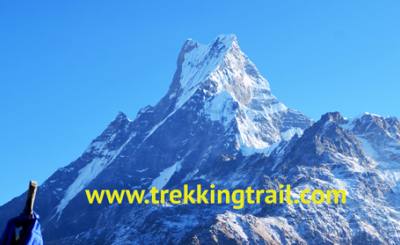North Annapurna Base Camp Trek, also known as the Maurice Herzog Trail, is a less-explored and pristine trekking trail to the base of Mount Annapurna. This trail is perfect for adventurers seeking an alternative route in the Annapurna region, offering a unique and exhilarating experience.
A Hidden Gem in the Annapurna Region: Discover the Maurice Herzog Trail
Explored in 2019 by the Annapurna Rural Municipality (ARM) group, the North Annapurna Base Camp Trek stands out for its untouched beauty and thrilling journey. This trail is gaining attention thanks to the combined efforts of the Trekking Agencies Association of Nepal (TAAN), the Annapurna Conservation Area Project (ACAP), local communities, and the Ministry of Tourism.
Why Choose the Maurice Herzog Trail?
- Less Crowded: Unlike other popular trails in the Annapurna region, this trek remains less crowded, allowing trekkers to immerse themselves in the serene natural beauty.
- Pristine Landscapes: The trail offers stunning views of the Annapurna range, lush forests, and diverse wildlife, making it a nature lover's paradise.
- Historic Significance: Named after Maurice Herzog, the first climber to summit an 8,000-meter peak, this trail is steeped in mountaineering history.
Why You Will Love the North Annapurna Base Camp
- Discover the Magic of the Himalayas: The North Annapurna Base Camp trek is a moderately challenging adventure, but the reward is the immense natural beauty of the Himalayas.
- Mesmerizing Mountain Views: As you journey along the trail and reach the camp, you'll be treated to stunning vistas of some of the world's most iconic peaks, including Annapurna I, Mount Machhapuchhre, Himchuli, and Dhaulagiri.
- Enchanting Natural Landscapes: The path to the North Annapurna Base Camp weaves through dense green forests, cascading waterfalls, rejuvenating hot springs, mysterious caves, and majestic glaciers.
- Visit Narchyang Village and Waterfall: One of the highlights of this trek is Narchyang Village and the waterfall, which transforms into a frozen wonderland during the winter months.
- Rich Biodiversity: The North Annapurna region is teeming with biodiversity. You'll encounter a variety of flora and fauna, including rare wildlife such as musk deer, snow leopards, bears, wild dogs, and blue sheep.
-
Promoting Sustainable Tourism: Efforts are being made to promote this historic route among various groups, travel agencies, and individual trekkers. By choosing the North Annapurna Base Camp Trek, you are supporting sustainable tourism and helping local communities.
Embark on this trek to experience the unparalleled beauty and diverse natural wonders of the North Annapurna Base Camp.
Short History of the Annapurna North Base Camp
On June 3, 1950, an expedition team led by Maurice Herzog made history by becoming the first climbers to reach the summit of Mount Annapurna. This remarkable achievement was also the first successful ascent of an 8000-meter peak. In honor of this historic feat, the trail to Annapurna North Base Camp is often referred to as the Maurice Herzog trail. Alternatively known as the French North Face route, this trail gained its name after the French group successfully conquered the summit of Mount Annapurna I and explored its formidable North Face. Despite its historical significance, the trail remains one of the least crowded paths due to its challenging terrain.
Trekkers should note that there are no tea houses or accommodation facilities along much of the trail, necessitating overnight camping. This lack of infrastructure adds to the trail's appeal for those seeking a more solitary and rugged trekking experience.
North Annapurna Base Camp Trek Itinerary: 5 Days
Day 1: Drive from Pokhara to Tatopani to Humkhola (2890 m)
- Driving Hours: 6-7 hours / 115 km
- Highest Altitude: 2890 m
After breakfast at the hotel, we drive to Hum Khola. Our route takes us through Baglung, crossing Kande, Nayapul, Kusma, and Parbat. The road from Pokhara to Baglung is generally good, taking about 3 hours. From Baglung, the road becomes off-road, leading us through Beni and Tatopani, where we'll have lunch. Continuing towards Hum Khola, we enjoy the scenery of deep gorges and hydropower projects. After 6 hours of driving, we reach Hum Khola, the last point for motorable roads, where we pitch our tents for the night.
- Overnight: Camping at Hum Khola
- Included Meals: Lunch, Dinner
Day 2: Trek from Humkhola to Busket Mela (3650 m)
- Highest Altitude: 3650 meters
- Trek Duration: 6 hours
- Trek Distance: 6 km approx
After breakfast, we start our trek to Busket Mela. The trek involves a gradual ascent to minimize the risk of altitude sickness. Along the way, we pass by the stunning Futfutey waterfall and stop at Sandikharka for a rest and snacks. Continuing, we reach Ghupaphant with views of Tilicho Peak. After 6 hours of trekking, we arrive at Busket Mela, where we pitch our tents near a river for an overnight stay.
- Overnight: Camping at Busket Mela
- Included Meals: Breakfast, Lunch, Dinner
Day 3: Trek from Busket Mela to Campsite (4050 m)
- Highest Altitude: 4050 meters
- Trek Duration: 4 hours
- Trek Distance: 6 km approx
The soothing sound of the river greets us in the morning. After breakfast, we head towards the Campsite. The trek is characterized by rocky roads and impressive rock formations. We pass several waterfalls and streams, including the SunKhola, known for its golden stones. After 4 hours of trekking, we reached the Campsite near Panchakunda Lake, where we set up camp.
- Overnight: Camping at the Campsite
- Included Meals: Breakfast, Lunch, Dinner
Day 4: Trek to North Annapurna Base Camp (4190 m) and Drive Back to Tatopani
- Driving Hours: 2 hours
- Highest Altitude: 4190 m
- Trek Duration: 6 hours
- Trek Distance: 11 km
We leave for North Annapurna Base Camp after breakfast. The pristine and isolated environment allows us to witness wildlife, such as Himalayan blue sheep. We pass a Shiva temple and the turquoise Narchyang Lake, a significant site for Hindu and Buddhist pilgrims. At the base camp (4190 m), we enjoy spectacular views of peaks like North Nilgiri and Annapurna I. After taking in the views, we trek back to Hum Khola and drive to Tatopani for a relaxing soak in the hot springs.
- Overnight: Hotel in Tatopani
- Included Meals: Breakfast, Lunch, Dinner
Day 5: Drive from Tatopani to Pokhara (800 m)
- Driving Hours: 4 hours / 102 km
- Highest Altitude: 800 m
On the final day, we enjoy breakfast and another dip in the hot springs of Tatopani. We then drive back to Pokhara, concluding our North Annapurna Base Camp trek. From here, you can choose to extend your trip to Kathmandu, Jomsom, or even the South Annapurna Base Camp Trek with Trekking Trail Nepal.
- Included Meals: Breakfast
North Annapurna Base Camp Trek Weather: Best Seasons and Conditions
The weather in the high Himalayas, particularly at the North Annapurna Base Camp, is notoriously unpredictable. However, certain seasons offer more favorable conditions for trekkers.
Autumn and Spring: Ideal Trekking Seasons:
Most trekkers prefer the Autumn (September to November) and Spring (March to May) seasons. During these times, the weather is typically stable, with clear skies and minimal rainfall. Snowfall is also rare, making it easier to navigate the trails and enjoy the stunning mountain views.
Weather Challenges at High Altitude
Even during the best seasons, trekkers should be prepared for sudden weather changes. At high altitudes, fog is a common occurrence and can obscure the breathtaking vistas of the Himalayas. This is why many trekkers choose to hike when there is a lower chance of fog and precipitation, ensuring they can fully appreciate the scenery.
Planning Your Trek
When planning your North Annapurna Base Camp trek, consider these weather patterns to maximize your experience. The clear skies and mild temperatures of Autumn and Spring provide the best opportunities for a successful and enjoyable trek.
North Annapurna Base Camp Trek Permits: All You Need to Know About Annapurna Conservation Area Permits and TIMS
Embarking on the North Annapurna Base Camp Trek is a thrilling adventure that requires careful planning and preparation. One crucial aspect of this preparation is understanding and obtaining the necessary permits. Here's a comprehensive guide to the permits you need for the North Annapurna Base Camp Trek.
Annapurna Conservation Area Permit (ACAP)
To trek in the Annapurna region, you must secure the Annapurna Conservation Area Permit (ACAP). This permit is essential for preserving the natural and cultural heritage of the Annapurna Conservation Area. The cost for the ACAP is typically around US$ 25 per person. The fee contributes to the maintenance of trails, conservation efforts, and the well-being of local communities.
Trekkers’ Information Management System (TIMS)
In addition to the ACAP, trekkers must also obtain the Trekkers' Information Management System (TIMS) card. The TIMS card helps track trekkers in the region, enhancing their safety and security. It is mandatory for all trekkers and can be obtained through registered trekking agencies or the Nepal Tourism Board.
Why Are These Permits Important?
The ACAP and TIMS permits serve several essential purposes:
Conservation: The fees collected support environmental conservation efforts in the Annapurna region.
Safety: The TIMS card ensures trekkers can be tracked in case of emergencies.
Community Support: Funds from the permits aid in the development and well-being of local communities within the conservation area.
How to Obtain Your Permits
- Visit the Nepal Tourism Board: You can apply for both permits at the Nepal Tourism Board offices in Kathmandu or Pokhara.
- Through a Trekking Agency: If you are trekking with a registered agency, they will typically handle the permit process for you, Trekking Trail Nepal will care of all these requirements for your North Annapurna Base Camp Trek.
- Online Application: Some permits can be applied for online through official websites, simplifying the process before you arrive in Nepal.
Conclusion
Securing your Annapurna Conservation Area Permit and TIMS card is a crucial step in your trekking journey. Not only do these permits ensure your safety and the conservation of the region, but they also support the local communities you will encounter along the way. Prepare in advance to enjoy a seamless and unforgettable trek to the North Annapurna Base Camp. By understanding and complying with these permit requirements, you contribute to the sustainable and responsible tourism practices that keep the Annapurna region pristine and welcoming for future adventurers. Trekking Trail Nepal offers Classical Short ABC Trek 5 Days too.
North Annapurna Base Camp Trek Cost: Includes and Excludes
What's Included?
- All Ground Transfers: Private vehicles for all ground transfers as per the itinerary.
- Experienced Guide: A highly experienced, helpful, and friendly guide, including his food, accommodation, salary, equipment, and accidental insurance.
- Porter Services: One porter to carry kitchen goods and camping equipment during the trek.
- Camping Gear: Camping tents and kitchen tents provided during the trek.
- Trekking Equipment: Sleeping bags, crampons, and trekking poles (if necessary), to be returned after the trip.
- Meals: Most meals are provided during the camping trek. You can choose dishes before departure.
- Breakfast: Options include porridge, rice pudding, egg dishes with toast, bread with jam and honey, and hot drinks like tea or coffee.
- Lunch & Dinner: Options include Dal Bhat (highly recommended), noodle soup/fried noodles, egg curry with plain rice, Thukpa, French fries, fried potatoes, boiled potatoes, and more.
- Permits: Complete trekking arrangements including the required TIMS for trekkers and Annapurna Conservation Area Permit (ACAP).
- First Aid: Medical kit with an oximeter.
- Taxes and Charges: VAT, government taxes, local taxes, and office service charges.
- Souvenirs: North Nepal T-shirt and a trekking/expedition achievement certificate.
- Refreshments: Fresh/dry fruits along the trek and tea/coffee breaks during the trek.
What's Excluded?
- International Flight Costs: Nepal entry visa fees, excess baggage charges, international flight tickets, and other related expenses.
- Extra Accommodations: Additional night accommodations due to itinerary changes.
- Additional Porter Services: Extra supporters or porters to carry your personal luggage during the trek.
- Personal Expenses: Expenses before the trek such as cold drinks, alcoholic beverages, telephone calls, WiFi, cell phone and camera battery recharges, and other personal items.
- Travel Insurance: Insurance covering high-altitude helicopter rescue, evacuation, and medical costs.
- Tips and Gratuities: Tips for guides and porters.
- Unforeseen Costs: Additional costs due to delays caused by natural or uncontrollable phenomena such as bad weather, landslides, itinerary modifications due to safety concerns, illness, etc.
- Unlisted Costs: Any costs and expenses not listed in the “What’s Included?” section.
Trekking Equipment for North Annapurna Base Camp Trek:
Trekking to the North Base Camp of Annapurna I offers a thrilling adventure in a pristine natural environment. This route is rarely trekked, making it essential to plan carefully. We highly recommend trekking with a professional agency due to the remote and challenging nature of this trail. Trekking Trail Nepal will cover all, just take the personal items that will make your adventure comfortable.
Essential Camping Gear
- Tents: Since there are no tea houses along the route, you'll need durable, weather-resistant tents for shelter.
- Sleeping Bags: Choose high-quality sleeping bags rated for low temperatures to stay warm during cold nights.
- Cooking Equipment: A portable food cooking stove and fuel are crucial for preparing meals. Ensure you bring enough supplies for the entire trek.
Personal Gear and Clothing
- Layered Clothing: Pack moisture-wicking base layers, insulating mid-layers, and a waterproof outer layer to adapt to varying weather conditions.
- Footwear: Sturdy, waterproof trekking boots with good ankle support are essential. Bring extra socks to keep your feet dry.
- Backpack: A comfortable, well-fitted backpack with a capacity of at least 50 liters to carry your gear.
- Accessories: Hats, gloves, sunglasses, and sunscreen to protect against the sun and cold.
Navigation and Safety
- Maps and Compass: Since few guides know the route, reliable navigation tools are a must.
- First Aid Kit: A comprehensive first aid kit tailored for high-altitude trekking can be lifesaving.
- Communication Devices: Satellite phones or GPS devices for emergency communication.
Additional Items
- Water Purification: Portable water filters or purification tablets to ensure safe drinking water.
- Trekking Poles: These can help maintain balance and reduce strain on your legs during steep ascents and descents.
- Headlamp: A reliable headlamp with extra batteries for nighttime visibility.
For a detailed packing list and more information on trekking to North Annapurna Base Camp, Trekking Gear Checklist. Planning ahead and having the right equipment will ensure a safe and enjoyable trek. Happy Adventure with Trekking Trail Nepal.
Alternative 9-Day Itinerary for North Annapurna Base Camp Trek
Day 1: Drive from Pokhara to Tatopani
Duration: 5 Hours
Max Altitude: 1,190 m
Begin your North Annapurna Base Camp trek with a scenic 5-hour drive from Pokhara to Tatopani. Enjoy the lush greenery, rhododendron forests, and panoramic Himalayan views along the way. We’ll make a few stops for photos and refreshments before settling into a guesthouse in Tatopani, where you can relax and unwind in the natural hot springs.
Meals: Breakfast, Lunch, & Dinner
Accommodation: Tea House/Guest House
Day 2: Trek from Tatopani to Ghasa
Duration: 5-6 Hours
Max Altitude: 2,012 m
After breakfast, we’ll start our trek to Ghasa. Though transportation is available, trekking is recommended for better acclimatization. The trail takes you through charming villages, lush forests, and scenic waterfalls. Overnight in a tea house in Ghasa.
Meals: Breakfast, Lunch, & Dinner
Accommodation: Tea House/Guest House
Day 3: Trek from Ghasa to Lete
Duration: 5-6 Hours
Max Altitude: 2,438 m
Continue your trek from Ghasa to Lete, a Himalayan village surrounded by the Annapurna, Dhaulagiri, and Nilgiri ranges. While transportation is available, we suggest trekking to fully enjoy the landscape. Spend the night in a tea house in Lete.
Meals: Breakfast, Lunch, & Dinner
Accommodation: Tea House/Guest House
Day 4: Trek from Lete to Thulo Bugin
Duration: 4 Hours
Max Altitude: 3,260 m
Trek from Lete to Thulo Bugin, gaining 822 meters in altitude. This shorter trek will reveal changes in the landscape. Camp in Thulo Bugin for the night, with meals prepared by the camping team.
Meals: Breakfast, Lunch, & Dinner
Accommodation: Tented Camp
Day 5: Trek from Thulo Bugin to Miristi Khola
Duration: 6-7 Hours
Max Altitude: 4,400 m
Cross the Thulo Bugin Pass (4,400 m), the highest point of the trek. The trek to Miristi Khola involves gaining altitude gradually. Camp by the river at Miristi Khola and enjoy stargazing and the soothing sounds of the river.
Meals: Breakfast, Lunch, & Dinner
Accommodation: Tented Camp
Day 6: Trek from Miristi Khola to Annapurna North Base Camp
Duration: 6-7 Hours
Max Altitude: 4,190 m
Trek to the Annapurna North Base Camp, navigating through challenging trails. Enjoy the pristine wilderness, campfire, and stunning sunset views over the Himalayas.
Meals: Breakfast, Lunch, & Dinner
Accommodation: Tented Camp
Day 7: Trek from Annapurna North Base Camp to Chhote Pa
Duration: 7-8 Hours
Max Altitude: 2,455 m
Depart early to witness the sunrise before trekking to Chhote Pa. This longer trek involves crossing icy paths, rockfalls, and lush green hills. Camp overnight in Chhote Pa, the last camp of the trek.
Meals: Breakfast, Lunch, & Dinner
Accommodation: Tented Camp
Day 8: Trek from Chhote Pa to Tatopani
Duration: 6-7 Hours
Max Altitude: 1,190 m
Trek back to Tatopani, passing through villages and farmlands. Enjoy the diverse local culture and lush green valleys. Spend the night in a guesthouse and relax in the hot springs.
Meals: Breakfast, Lunch, & Dinner
Accommodation: Tea House/Guest House
Day 9: Drive from Tatopani to Pokhara
Max Altitude: 1,400 m
After a local breakfast and a final stroll around Tatopani, drive back to Pokhara, marking the end of your adventure. Reflect on your thrilling experiences and the unforgettable memories created.
Meals: Breakfast, Lunch
This itinerary offers a comprehensive experience of the North Annapurna Base Camp trek, balancing challenging treks with rewarding landscapes and local culture, and can be combined with the Annapurna Circuit or Upper Mustang Trek.
7-Day Alternative Itinerary for the North Annapurna Base Camp Trek
Day 1: Drive from Pokhara to Narchyang Village
- Drive: 5 hours
- Altitude: 1,530 m
- Overnight: Homestay
Kick off your adventure with a scenic drive from Pokhara to the charming Narchyang Village, where you'll settle into a cozy homestay for the night.
Day 2: Narchyang Village to Chottepa
- Trek: 7 hours
- Altitude: 2,370 m
- Overnight: Camping
Embark on a challenging trek from Narchyang Village to Chottepa. The journey will reward you with stunning landscapes as you camp under the stars.
Day 3: Chhotepa to Sandikharka
- Trek: 5-6 hours
- Altitude: 3,160 m
- Overnight: Camping
Continue your trek from Chhotepa to Sandikharka. The trail offers breathtaking views, and you'll set up camp for the night at this higher altitude.
Day 4: Sandikharka to Campsite
- Trek: 5 hours
- Altitude: 4,050 m
- Overnight: Camping
Ascend from Sandikharka to your high-altitude campsite. Enjoy the panoramic vistas and prepare for the next day's exploration.
Day 5: Explore North Annapurna Base Camp & Return to Thulobugin Pass
- Trek: 7 hours
- Altitude: 4,190 m (Base Camp) / 4,310 m (Thulobugin Pass)
- Overnight: Camping
Spend the day at the North Annapurna Base Camp, soaking in the majestic surroundings before heading back to Thulobugin Pass for the night.
Day 6: Thulobugin to Ghasa
- Trek: 6 hours
- Altitude: 3,260 m
- Overnight: Camping
Descend from Thulobugin to Ghasa, where you'll camp and reflect on the incredible journey so far.
Day 7: Drive from Ghasa to Pokhara
- Drive: 6 hours
- Altitude: 2,438 m
Conclude your trek with a scenic drive back to Pokhara, filled with memories and experiences from your North Annapurna Base Camp adventure.
Most Common Questions (FAQs) for North Annapurna Base Camp Trekking Trail.
1. Is Travel Insurance Required for the North Annapurna Base Camp Trek?
Yes, travel insurance is mandatory for the North Annapurna Base Camp trek. The trek is challenging and located in a remote area with limited access to communication. Therefore, it's strongly recommended to have travel and medical insurance that covers up to 6,000 meters altitude for your safety and peace of mind. The cost of helicopter rescue is high, making insurance even more crucial.
2. Can I Do the North Annapurna Base Camp Trek Without a Guide?
While it is possible to undertake the North Annapurna Base Camp trek without a guide, it is not advisable. The ANBC trail is not well-established and requires 3 to 4 days of camping in challenging terrain. Experience in setting up camp at high altitudes and proper gear are essential. Additionally, the trail includes areas prone to landslides, adding an element of risk. An experienced guide can read the land, understand its intricacies, and foresee complications, making them invaluable for this trek.
3. Could You Trek to the North Annapurna Base Camp Alone?
No, due to new regulations by the Nepal Tourism Board (NTB), solo trekking is not allowed. Given the complexities and inherent risks of the trail, hiring an experienced guide is highly recommended. A local expert can significantly enhance your trekking experience and safety.
4. When is the Best Time to Travel to Annapurna North Base Camp?
The North Annapurna Base Camp trek is rewarding year-round, but specific periods offer unique experiences. The best times are from March to June and September to November, when the weather is sunny and breezy, making the trek more enjoyable.
March to May: Expect a winter wonderland with clear skies and magical snowfall covering the hills. Narchyang Lake freezes and transforms into a winter marvel.
October to December: Experience crystal-clear skies and a landscape that shifts to dry and brown hues.
5. What About Food and Accommodation?
Tea houses are available only on the first day of the trek. For the remaining days, trekkers need to camp. All necessary camping gear and tools should be carried from the beginning. Since nights will be spent in tents, dry foods are a must, and other food items should be taken along for self-cooking.
6. How Hard is This Trek?
The trek is moderately challenging. The ongoing construction of the Hydropower Project has left the tracks mostly covered by stones and mud, making navigation difficult. Some areas are prone to landslides, with trails often layered with rocks and dirt. The paths are steep and may require ropes for support. Compared to other treks, the North Annapurna Base Camp trek is relatively harder.
Conclusion: Annapurna North Base Camp Trek
If you're looking for an alternative trekking trail in the Annapurna region which blends adventure, history, and natural beauty, the North Annapurna Base Camp Trek is the perfect choice. Explore the Maurice Herzog Trail and create unforgettable memories in one of Nepal's most pristine trekking destinations with Trekking Trail Nepal.
